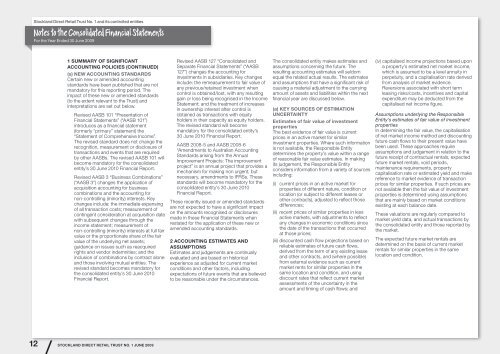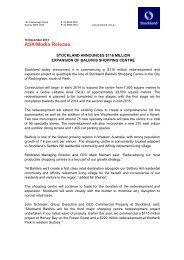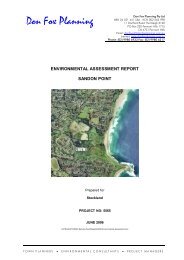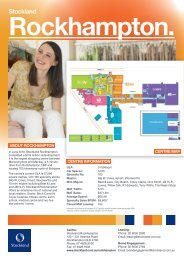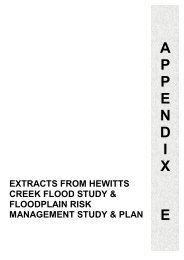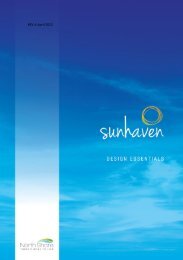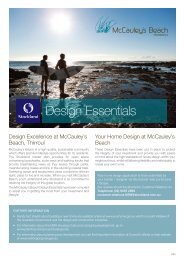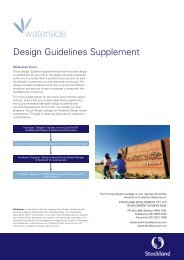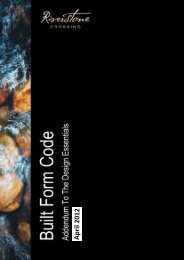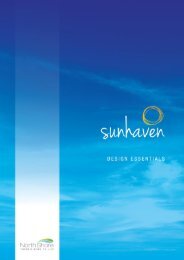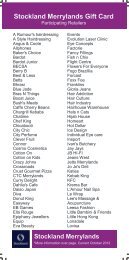Stockland Direct Retail Trust No.1
Stockland Direct Retail Trust No.1
Stockland Direct Retail Trust No.1
Create successful ePaper yourself
Turn your PDF publications into a flip-book with our unique Google optimized e-Paper software.
<strong>Stockland</strong> <strong>Direct</strong> <strong>Retail</strong> <strong>Trust</strong> No. 1 and its controlled entities<br />
Notes to the Consolidated Financial Statements<br />
For the Year Ended 30 June 2009<br />
1 Summary of significant<br />
accounting policies (continued)<br />
(s) New accounting standards<br />
Certain new or amended accounting<br />
standards have been published that are not<br />
mandatory for this reporting period. The<br />
impact of these new or amended standards<br />
(to the extent relevant to the <strong>Trust</strong>) and<br />
interpretations are set out below.<br />
Revised AASB 101 “Presentation of<br />
Financial Statements” (“AASB 101”)<br />
introduces as a financial statement<br />
(formerly “primary” statement) the<br />
“Statement of Comprehensive Income”.<br />
The revised standard does not change the<br />
recognition, measurement or disclosure of<br />
transactions and events that are required<br />
by other AASBs. The revised AASB 101 will<br />
become mandatory for the consolidated<br />
entity’s 30 June 2010 Financial Report.<br />
Revised AASB 3 “Business Combinations”<br />
(“AASB 3”) changes the application of<br />
acquisition accounting for business<br />
combinations and the accounting for<br />
non-controlling (minority) interests. Key<br />
changes include: the immediate expensing<br />
of all transaction costs; measurement of<br />
contingent consideration at acquisition date<br />
with subsequent changes through the<br />
income statement; measurement of<br />
non-controlling (minority) interests at full fair<br />
value or the proportionate share of the fair<br />
value of the underlying net assets;<br />
guidance on issues such as reacquired<br />
rights and vendor indemnities; and the<br />
inclusion of combinations by contract alone<br />
and those involving mutual entities. The<br />
revised standard becomes mandatory for<br />
the consolidated entity’s 30 June 2010<br />
Financial Report.<br />
Revised AASB 127 “Consolidated and<br />
Separate Financial Statements” (“AASB<br />
127”) changes the accounting for<br />
investments in subsidiaries. Key changes<br />
include: the remeasurement to fair value of<br />
any previous/retained investment when<br />
control is obtained/lost, with any resulting<br />
gain or loss being recognised in the Income<br />
Statement; and the treatment of increases<br />
in ownership interest after control is<br />
obtained as transactions with equity<br />
holders in their capacity as equity holders.<br />
The revised standard will become<br />
mandatory for the consolidated entity’s<br />
30 June 2010 Financial Report.<br />
AASB 2008-5 and AASB 2008-6<br />
“Amendments to Australian Accounting<br />
Standards arising from the Annual<br />
Improvement Projects: The improvement<br />
project” is an annual project that provides a<br />
mechanism for making non urgent, but<br />
necessary, amendments to IFRSs. These<br />
standards will become mandatory for the<br />
consolidated entity’s 30 June 2010<br />
Financial Report.<br />
These recently issued or amended standards<br />
are not expected to have a significant impact<br />
on the amounts recognised or disclosures<br />
made in these Financial Statements when<br />
restated for the application of these new or<br />
amended accounting standards.<br />
2 Accounting estimates and<br />
assumptions<br />
Estimates and judgements are continually<br />
evaluated and are based on historical<br />
experience as adjusted for current market<br />
conditions and other factors, including<br />
expectations of future events that are believed<br />
to be reasonable under the circumstances.<br />
The consolidated entity makes estimates and<br />
assumptions concerning the future. The<br />
resulting accounting estimates will seldom<br />
equal the related actual results. The estimates<br />
and assumptions that have a significant risk of<br />
causing a material adjustment to the carrying<br />
amount of assets and liabilities within the next<br />
financial year are discussed below.<br />
(a) Key sources of estimation<br />
uncertainty<br />
Estimates of fair value of investment<br />
properties<br />
The best evidence of fair value is current<br />
prices in an active market for similar<br />
investment properties. Where such information<br />
is not available, the Responsible Entity<br />
determines the property’s value within a range<br />
of reasonable fair value estimates. In making<br />
its judgement, the Responsible Entity<br />
considers information from a variety of sources<br />
including:<br />
(i) current prices in an active market for<br />
properties of different nature, condition or<br />
location (or subject to different leases or<br />
other contracts), adjusted to reflect those<br />
differences;<br />
(ii) recent prices of similar properties in less<br />
active markets, with adjustments to reflect<br />
any changes in economic conditions since<br />
the date of the transactions that occurred<br />
at those prices;<br />
(iii) discounted cash flow projections based on<br />
reliable estimates of future cash flows,<br />
derived from the term of any existing lease<br />
and other contracts, and (where possible)<br />
from external evidence such as current<br />
market rents for similar properties in the<br />
same location and condition, and using<br />
discount rates that reflect current market<br />
assessments of the uncertainty in the<br />
amount and timing of cash flows; and<br />
(iv) capitalised income projections based upon<br />
a property’s estimated net market income,<br />
which is assumed to be a level annuity in<br />
perpetuity, and a capitalisation rate derived<br />
from analysis of market evidence.<br />
Reversions associated with short term<br />
leasing risks/costs, incentives and capital<br />
expenditure may be deducted from the<br />
capitalised net income figure.<br />
Assumptions underlying the Responsible<br />
Entity’s estimates of fair value of investment<br />
properties<br />
In determining the fair value, the capitalisation<br />
of net market income method and discounting<br />
future cash flows to their present value have<br />
been used. These approaches require<br />
assumptions and judgement in relation to the<br />
future receipt of contractual rentals, expected<br />
future market rentals, void periods,<br />
maintenance requirements, property<br />
capitalisation rate or estimated yield and make<br />
reference to market evidence of transaction<br />
prices for similar properties. If such prices are<br />
not available then the fair value of investment<br />
properties is determined using assumptions<br />
that are mainly based on market conditions<br />
existing at each balance date.<br />
These valuations are regularly compared to<br />
market yield data, and actual transactions by<br />
the consolidated entity and those reported by<br />
the market.<br />
The expected future market rentals are<br />
determined on the basis of current market<br />
rentals for similar properties in the same<br />
location and condition.<br />
12<br />
<strong>Stockland</strong> <strong>Direct</strong> <strong>Retail</strong> <strong>Trust</strong> No. 1 June 2009


